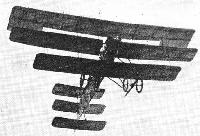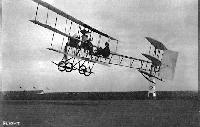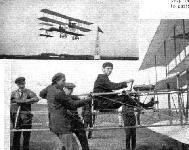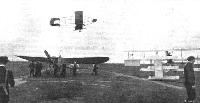A.Jackson Avro Aircraft since 1908 (Putnam)
Roe III Triplane
The 'prototype' Roe III was a two seater, structurally similar to Roe II, but with the important difference that the mainplanes were fixed to the fuselage, climbing and diving being effected for the first time by means of a tail elevator. The aspect ratio was 8 and the bottom wing was cut back to a span of only 20 feet. The lifting tail remained, but as a result of experiments with the triplane "Mercury", lateral control was by means of ailerons (5 ft. span x 2 ft. chord), this time hinged to the rear spar of the top wing so that they were slightly inset. By this time the functions of the rudder were better understood and this organ was increased in size to a rectangle equal in height to the maximum tailplane gap as on the modified Roe II. A more robust undercarriage was of the twin-skid, four wheel Farman type and the engine a 35 h.p. J.A.P. eight cylinder Vee aircooled unit.
First taxying trials were made at Brooklands by A. V. Roe on the evening of June 21, 1910 and the first straights were flown in a tricky wind on June 24. Flight times gradually increased until on July 4 he made a best flight of 11 minutes (with 'just a touch' after 3 1/2 minutes) and later in the day carried his mother and several other passengers. Roe seldom exceeded 20 minutes in the air in the 'prototype' Roe III because the J.A.P. engine had a tendency to overheat and cover pilot and passenger with sooty oil ejected from the scavenging holes at the base of the cylinder walls. Carburettor fires were frequent but Roe persevered until on July 9 he remained aloft for 25 minutes and made comparatively steep turns. He also practised figure eights in readiness for Royal Aero Club tests which he passed on this aircraft on July 20. Aviator's Certificate No. 18 was issued to the great pioneer on July 26, but within a year he had given up piloting in favour of designing and did not take the Air Ministry's 'A' Licence tests when they came into being in 1919. He kept no log books and did not know how many hours he had flown as pilot. The J.A.P. engined Roe III was advertised secondhand by the makers for ?250 in May 1911 but its ultimate fate is uncertain.
The three subsequent triplanes of this type (all powered by 35 h.p. Green four cylinder, watercooled engines) had the span of the top mainplane increased to 31 ft. and were fitted with ailerons hinged to the rear spar of the centre wing. First of these, identified by rounded corners to the trailing edge of the rudder and by fuselage covering applied only in the region of the cockpits, was a special slow flying aircraft with a more heavily cambered wing section for instructional use at the Avro School. Piloted by the designer, this triplane first flew at Brooklands on July 9, 1910 and its performance was at once encouraging. Both Roe and Pixton carried passengers on July 13 and one another on the following day. At the end of the month the machine was sent by train from Weybridge to the Blackpool meeting only to destroyed by fire en route together with the Roe II "Mercury".
Determined to compete, Roe and Pixton hastily brought spare components from the Manchester works to Blackpool and arranged for a new engine to be delivered direct from the Green factory. Work started on Thursday July 28 and the finished aircraft flew on Monday August 1, much of the erection having been done by Roe himself during the previous night. There was not even time to cover the fuselage. Three attempts were made to take off, during which a tyre burst and some rubber shock absorbers snapped. Two struts were broken on landing but not before Roe had made four circuits of the course, at least two with passengers (who could face forward or backward according to taste). For this he received a special merit award of ? 50. August 2 dawned wet and windy but after repairs Roe succeeded in making two more short hops at 7.30 p.m. and on the following afternoon left the ground in a much more lively manner. In turning, the wind carried him dangerously close to one of the pylons, to avoid which he had no alternative but to make a crash landing, breaking several more struts, the airscrew and one mainplane.
Visitors to the Blackpool meeting included J. V. Martin, organiser of the Harvard University Aeronautical Society, who ordered a Roe III triplane which was built, crated and despatched (without engine) to the U.S.A. by August 13! A. V. Roe and Claude Grahame-White were also invited to fly at the Boston Aviation Meeting scheduled to open on September 2. They left in the White Star liner Cymric on August 23, Roe taking with him the makeshift Blackpool triplane in a 40 ft. packing case. Arriving at Boston on September 1, they collected the Harvard Society's triplane (which had been stored at East Boston Docks since its arrival in the Cunarder Ivernia a week previously), and took all the aircraft by lighter to the airfield at Squantum Point. Here Roe and mechanics Pixton and Halstead completed the erection of the Blackpool triplane on September 3, but flights begun on September 6 were disappointing, the longest being 75 ft. at a height of 10 ft. At 5 p.m. the engine failed and the triplane landed heavily in front of the grandstand, damaging the starboard mainplanes and undercarriage. Local woodworker C. H. Metz made a new airscrew and at 6.30 p.m. on September 8 Roe succeeded in leaving the ground properly for the first time, reaching a height of 30 feet. When he shut off the engine to land, however, a sudden gust caused the aircraft to swerve to starboard and dig the right undercarriage skid into the ground, causing it to swing round with major breakages. Roe was unhurt and more determined than ever to show the Americans that his triplanes were more than just interesting freaks. On September 9 he secured permission from Harvard to erect the Society's triplane and fit it with the 35 h.p. Green engine taken from the wreck. Erection was completed and engine runs made on September 12 and it is said that the aircraft was slightly heavier than its predecessor and had two instead of four wheels. Two days later, amid the applause of 10,000 spectators, successful flights were made up to a height of 50 feet but the engine still refused to give full power. After tinkering with it for most of September 15, Roe made a good take-off at 4.20 p.m. and flew the length of the field. In attempting to round the pylon, he sideslipped into the ground from 50 feet, totally wrecking the port side of the aircraft and suffering a severe scalp wound. A cordon of police saved the wreck from souvenir hunters and after A. V. Roe returned to England, Pixton built a new triplane for Harvard out of the remains of the other two. He then sold the surplus spares to the local aircraft firm of Burgess and Co. and Curtiss of Marblehead to raise money for his passage home, leaving Harvard with their machine untested in the air.
SPECIFICATION AND DATA
Manufacturers: A. V. Roe and Company, Brownsfield Mills, Great Ancoats Street, Manchester; and Brooklands Aerodrome, Byfleet, Surrey
Power Plants:
One 35 h.p. J.A.P.
One 35 h.p. Green
Dimensions:
Span (upper) 31 ft. 0 in. (lower) 20 ft. 0 in.
Length 23 ft. 0 in. Wing area 287 sq. ft.
Tailplane area 75 sq. ft.
Weight: All-up weight 750 lb.
Production:
No. 1 Prototype with 35 h.p. J.A.P., first flown 24.6.10, up for sale 5.11
No. 2 Avro School machine, first flown 9.7.10, burned out 27.7.10
No. 3 Blackpool makeshift machine, first flown 1.8.10, crashed at Boston, U.S.A. 8.9.10
No. 4 Harvard Aeronautical Society machine, first flown (and crashed) at Boston, U.S.A. 15.9.10
Note: A work of reference of the period states that a triplane of this type was built for the great pioneer pilot Cecil Grace. This aircraft is conspicuous by its absence from contemporary records and diligent research by the author only makes it evident that no such aircraft existed.
M.Goodall, A.Tagg British Aircraft before the Great War (Schiffer)
Deleted by request of (c)Schiffer Publishing
ROE III triplanes
This was a larger machine capable of carrying a passenger in front of the pilot, facing either forward or aft. A major change from Roe II was to fix the wings at the fuselage and rely on the tail unit for control in pitch. Ailerons were fitted to the top wing on the first machine and on the center wing on the three subsequent machines. The substantial undercarriage was of Farman type with four wheels, although it is believed that on the fourth machine, only two were used. A JAP engine was fitted to the first machine and Green engines to the remainder.
This was the first Avro machine capable of fully controlled flight. 'AV' had flown "straights" on it for the first time on 4 July 1910. By 9 July 1910 he was making turns and figures of eight, being airborne for up to twenty-five minutes. He took his tests for the RAeC certificate on the 20 July 1910 and was issued with No. 18 a week later.
Power: 35hp JAP eight-cylinder air-cooled vee. 35hp Green four-cylinder inline water-cooled.
Data
Top and center span 31ft
Bottom span 20ft
Mainplane chord 3 ft 6in
Mainplane area 287 sq ft
Length 23ft
Tailplane span 8ft 4in
Tailplane chord 3ft
Tailplane area 75 sq ft
Weight allup 750 lb
No.1 35hp JAP first flown at Brooklands 24 June 1910. For sale May 1911.
No.2 35hp Green first flown at Brooklands 9 July 1910. Burnt on train on way to the Blackpool Flying Meeting 27 July 1910.
No.3 35hp Green Replacement built urgently after loss of No.2. Assembled at Blackpool. First flown at Blackpool 1 August 1910. Destroyed at Boston on 8 August 1910
No.4 35hp Green supplied to the Harvard Aeronautical Society less engine. First flown at Boston, Massachusetts in the United States using engine from No.3. Crashed but rebuilt.
P.Lewis British Aircraft 1809-1914 (Putnam)
Avro Triplanes 1, 2, 3 and 4
<...>
The next design by A. V. Roe and Co., the firm having been formed early in 1910, was the No. 3 Triplane, six of which were constructed in the Everard Brownsfield Mills. The new version was capable of carrying two passengers in tandem on 35 h.p. from either a J.A.P. or a Green engine and was more substantially built than the previous machines. Ailerons on the upper wings took the place of warping, the wings were fixed and elevators took over longitudinal control. The two upper wings had an equal span of 31 ft., while the lowest were shorter at 20 ft. On 26th July, 1910, Roe gained his Royal Aero Club Aviator's Certificate No. 18 on one of his triplanes at Brooklands. The first machine was sold to Capt. Walter Windham and the second and third, after testing at Brooklands, were loaded at Weybridge for transport by rail to the three weeks flying meeting at Blackpool due to begin on 28th July, 1910. The Green-engined machine crashed several times during its testing at Brooklands, but Roe thought that the J.A.P.-powered version was the best triplane that he built. However, both were destroyed on the train by fire before reaching Blackpool. Another, equipped with a Green engine, was assembled hurriedly in four days at Manchester from spare parts, and differed in having its ailerons on the middle wings. Roe took the replacement into the air at Blackpool and managed to collect ?75 in prize money.
The fourth production machine had been ordered by the Harvard Aeronautical Society and was due to be delivered at the Society's Flying Meeting being held from 3rd to 13th September, 1910, at Boston. Mass., U.S.A. Soon after the meeting opened Roe crashed his own triplane - the fifth one of the batch - and on his return from hospital took off in the Harvard aircraft. This crashed also, the Society receiving finally a triplane assembled from the remains of the two crashes. The engine was run up and the machine handed over before it was flown. The sixth and final No. 3 Triplane was built for Cecil Grace.
<...>
SPECIFICATION
AVRO 3
Description: Two-seat tractor triplane. Wooden structure, fabric covered.
Manufacturers: A. V. Roe & Co., Brownsfield Mills, Manchester.
Power Plant: 35 h.p. Green, 35 h.p. J.A.P.
Dimensions: Span, 31 ft. Length, 23 ft. Wing area, 362 sq. ft.
Weights: Loaded, 750 lb.
Журнал Flight
Flight, January 8, 1915.
MILESTONES.
IN reviewing the long list of modern successful aeroplanes, it is a little surprising to discover how comparatively few can trace their ancestry back, through generation after generation, so to speak, to a prototype which, although perhaps appearing somewhat crude and incomplete in many ways, viewed in the light of present-day knowledge of aeroplane design, had embodied in it nearly all the fundamental ideas that have contributed towards the success attained by its present-day descendants. One reason for the absence of "pedigree" in a good many successful modern machines is, no doubt, that of the pioneers that helped to make history in the earlier days of aviation, comparatively few are still numbered among the leading constructors, and of these again several are now producing machines which, although being classed among the very best of the day, cannot, strictly speaking, be said to be direct descendants of the original type. Among the British designers whose products can justly lay claim to being "Thoroughbreds" must be mentioned in the very front rank the Avros, in which the fundamental idea underlying the design can be traced very clearly back to the old machine on which A. V. Roe did his first flights, which, although they may not have been more than glorified "hops," were nevertheless, even compared to up-to-date achievements, remarkable performances, when it is remembered that they were coaxed out of a machine fitted with an engine of what seems today ridiculously low power. That the modern Avros have proved and are proving so successful is one more proof, if such were needed, that Mr. Roe had already, in those "dark ages," a thorough grasp of his subject, and was sufficiently far-seeing to choose as subject for his experiments a type which was capable of development. The fact that he had to not only overcome aerodynamical difficulties, but also to fight against financial handicaps makes his ultimate success all the more creditable.
It was in the dark ages when the man who had the temerity to venture the opinion that it was possible for man to fly was regarded by the majority of people as a dreamer and a crank, not to say worse, that A. V. Roe began his experiments. Accounts of his trials and triumphs, as well as of his adversities, are to be found in the first numbers of FLIGHT, and before the foundation of this journal in our sister journal the Auto., and very interesting reading they make. The "Bull's Eye," or Roe 1 triplane, with which Mr. Roe carried out a number of experiments on Lea Marshes in 1908-09 was a very frail affair as will be gathered from the fact that it turned the scale at about 200 lbs. and had a surface of some 300 sq. ft. The body, which was triangular in section, was built up of longerons of deal, the whole being covered with cotton-oiled paper backed with muslin. The engine, a 10 (ten) h.p. Jap, was mounted in the nose of the body, and drove through a reduction gearing a four-bladed propeller. A two-bladed propeller was also tried, and the question of gear ratios, pitch, width of blades and diameter was made the subject of extensive tests, the results of which were carefully noted. The main planes, of which there were three, were swivelled round a horizontal axis, and were at the same time capable of being warped to maintain lateral stability. The triplane tail of the lifting type was rigidly attached to the rear end of the body, and steering up or down was effected by keeping the tail stationary whilst the main planes were swivelled around their axis in order to increase or decrease the angle of incidence. The warping of the main planes and the alteration of the angle of incidence were both effected by a single horizontal lever, whilst the vertical rudder at the rear of the tail planes provided horizontal directional control. The pilot was seated inside the triangular section body some distance behind the main planes, a position which proved very safe in the numerous accidents that were experienced. Several short flights were made on this machine in 1909, the two first of which ended in left hand side-slips, which were at the time thought to be due to the torque of the propeller, but were proved by later experience to be more probably caused by unskilful steering.
Several machines on similar lines were built, flown, damaged, rebuilt, flown, &c, during 1909-1910, in the course of which experiments the engine power was increased from 10 to 20 and 35 h.p. The next step in the development of the Avros was a new triplane that made its appearance in 1910. In this machine the span of the two upper planes was increased from 20 ft. to 31 ft., whilst that of the lower plane remained as before, 20 ft. The most important change in this machine in addition to the increase in span was the rigid attachment of the main planes to the body, and the substitution of ailerons for warping for lateral control. The triplane tail remained fixed, but steering up and down was effected by a rear elevator instead of by tilting the main planes. The engine fitted to this machine was a 35 h.p. Jap.
<...>
 |
A.Jackson - Avro Aircraft since 1908 /Putnam/
|
| The Roe III triplane (35 h.p. J.A.P.) in flight with ailerons fitted to the top wing.
|
 |
P.Lewis - British Aircraft 1809-1914 /Putnam/
|
| Avro No. 3 Triplane at 1910 Boston Harvard Meeting.
|
 |
M.Goodall, A.Tagg - British Aircraft before the Great War /Schiffer/
|
| A. V. Roe seated in the 35 h.p. Green engined Roe III triplane at Squantum Point, Boston, U.S.A. in September 1911. This machine was destroyed by fire on the train on the way to the Blackpool Meeting. (Green engine).
|
 |
P.Lewis - British Aircraft 1809-1914 /Putnam/
|
| A. V. Roe carrying a passenger last week flying his No. 3 Triplane at the 1910 Blackpool Meeting.
|
 |
Журнал - Flight за 1910 г.
|
| A. V . Roe starting, on his triplane, for a flight at Blackpool Aerodrome. Inset he is seen In full flight round the course.
|
 |
Журнал - Flight за 1910 г.
|
| ONE, TWO AND THREE PLANES. - Grahame-White, in his Henry Farman biplane, flying over Drexel's Bleriot monoplane and Roe's triplane.
|
 |
M.Goodall, A.Tagg - British Aircraft before the Great War /Schiffer/
|
| Roe III Triplane. Four of these were built, including one exported to the United States. (JAP engine).
|
 |
H.Cowin - Aviation Pioneers /Osprey/
|
| Edwin Alliot Verdon Roe, seen here standing beside his Roe III two-seat triplane of 1910, was born near Manchester on 26 April 1877. 'AV' Showed an early aptitude for the more technical subjects, cemented by serving a five year apprenticeship at a railway works between 1893 and 1898. Next, 'A.V.' turned to things maritime, hoping to join the Royal Navy, but ending up by spending four years in the merchant marine. It was while at sea that 'A.V.' started to study bird flight, which by 1902 had led him into aeromodelling. 'A.V.'s success in this field got him the post of Secretary to the Aero Club in the spring of 1906, but the lure of joining an American project to build a steam-powered vertical take-off and landing aircraft proved too much and in a matter of weeks 'A.V.' had set off for Denver, Colorado. 'A.V.' Returned to Britain in the autumn of 1906, following the collapse of the project and by January 1907 had embarked on the design of his own first full-size, man-carrying aircraft, the 6hp JAP-powered Roe I canard biplane. Once re-engined with the more manful 25hp Antoinette, this machine, piloted by 'A.V.', made what was arguably the first flight by a British Aircraft on 8 June 1908. Just over a year later 'A.V.' Gained Aero Club Aviator's Certificate No 18, flying his Roe III triplane. During the whole of this period, from 1906 to 1910, 'A.V.' was living in near poverty. In 1910, with help from his family, 'A.V.' Founded 'A.V.' Roe and Company and in July 1911 gave up flying to concentrate on the design work that was to establish him as one of the country's leading aircraft designers, with such machines as his Avro 504. 'A.V.' sold his interest in Avro in 1928 and received his knighthood the following year, during which he bought a controlling interest in what was, thereafter, to be Saunders Roe, of which he remained President until his death on 4 January 1958.
|









